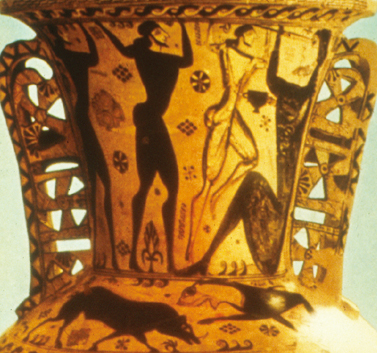This detail is from an early Black Figure Ware amphora and depicts the Blinding of Polyphemus in this upper portion of the vase. First, note the very unusual perforated handles flanking the neck of the amphora. Black Figure Ware was produced from roughly 700-500 BCE and evolved from the preceding Geometric style. This piece is clearly transitional. Note that the human body is now painted with an attempt at realism, and while the chest is still vaguely triangular, there is an attempt at modeling the figure and capturing the musculature of the figures. Faces are indicated now, with beards and hair indicated, along with the characteristic 'frontal' eye. Compare the painting style on this vase to the preceding Geometric style, and then to Black Figure Ware to follow, and the evolution of painting the human form can be seen.
Literacy among the population was rare, and vases such as this served to visually record the myths, legends, and conquests of the culture. In this example, we see the cyclops, Polyphemus, at far right. Polyphemus, most famous of the one-eyed cyclops, lived on the island of Sicily. When the hero of the Trojan was, Odysseus, was cast upon the shores of this island after a shipwreck with 12 of his men, the giant took the band of warriors captive and trapped them in a cave, blocking the entrance with a giant rock. Eventually, Odysseus succeeded in getting Polyphemus drunk (note the kylix, a drinking cup, in his right hand), and blinded him by plunging a burning stake into his gigantic, single eye. He then made his escape with his remaining 6 companions (the others already having been eaten by Polyphemus). This story, of course, relates to the aftermath of the Trojan War, an event that took place over 6 centuries before the amphora was painted. Other than the written record of Homer's Odyssey and Iliad, vases such as this are the only record we have of these events, clouded with the passage of time to become more myth than history.

Detail of the Blinding of Polyphemus, Early Black Figure Ware
Greek, 675-650 BCE


